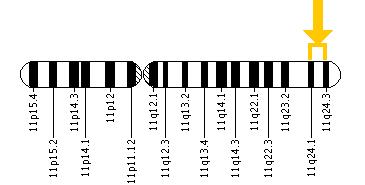 |
||
| http://ghr.nlm.nih.gov/ A service of the U.S. National Library of Medicine® | ||
The official name of this gene is “Friend leukemia virus integration 1.”
FLI1 is the gene's official symbol. The FLI1 gene is also known by other names, listed below.
The FLI1 gene provides instructions for making the FLI protein, which controls the activity (transcription) of genes. Transcription is the first step in the process of producing proteins. The FLI protein is part of a group of related proteins, called the Ets family of transcription factors, that control transcription. The FLI protein attaches (binds) to certain regions of DNA and turns on (activates) the transcription of nearby genes. The proteins produced from these genes control many important cellular processes, such as cell growth and division (proliferation), maturation (differentiation), and survival. The FLI protein is found primarily in blood cells and is thought to regulate their development.
Mutations involving the FLI1 gene cause a type of cancerous tumor known as Ewing sarcoma. These tumors develop in bones or soft tissues such as nerves and cartilage. There are several types of Ewing sarcoma, including Ewing sarcoma of bone, extraosseous Ewing sarcoma, peripheral primitive neuroectodermal tumor, and Askin tumor. The mutations that cause these tumors are acquired during a person's lifetime and are present only in the tumor cells. This type of genetic change, called a somatic mutation, is not inherited. The most common mutation that causes Ewing sarcoma is a rearrangement (translocation) of genetic material between chromosome 11 and chromosome 22. This translocation, written as t(11;22), fuses part of the FLI1 gene on chromosome 11 with part of another gene called EWSR1 on chromosome 22, creating an EWSR1/FLI1 fusion gene.
The protein produced from the EWSR1/FLI1 fusion gene, called EWS/FLI, has functions of the protein products of both genes. Like the FLI protein, the EWS protein, produced from the EWSR1 gene, can regulate transcription. The EWS/FLI protein has the DNA-binding function of the FLI protein as well as the transcription regulation function of the EWS protein. It is thought that the EWS/FLI protein turns the transcription of a variety of genes on and off abnormally. This dysregulation of transcription leads to uncontrolled growth and division (proliferation) and abnormal maturation and survival of cells, causing tumor development.
The EWSR1/FLI1 fusion gene occurs in approximately 85 percent of Ewing sarcomas. The remaining tumors result from translocations that fuse the EWSR1 gene with other genes.
Cytogenetic Location: 11q24.1-q24.3
Molecular Location on chromosome 11: base pairs 128,556,429 to 128,683,161

The FLI1 gene is located on the long (q) arm of chromosome 11 between positions 24.1 and 24.3.
More precisely, the FLI1 gene is located from base pair 128,556,429 to base pair 128,683,161 on chromosome 11.
See How do geneticists indicate the location of a gene? (http://ghr.nlm.nih.gov/handbook/howgeneswork/genelocation) in the Handbook.
You may also be interested in these resources, which are designed for genetics professionals and researchers.
See How are genetic conditions and genes named? (http://ghr.nlm.nih.gov/handbook/mutationsanddisorders/naming) in the Handbook.
cartilage ; cell ; chromosome ; differentiation ; DNA ; gene ; leukemia ; mutation ; oncogene ; peripheral ; proliferation ; protein ; proto-oncogene ; rearrangement ; sarcoma ; soft tissue ; somatic mutation ; tissue ; transcription ; transcription factor ; translocation ; tumor ; virus
You may find definitions for these and many other terms in the Genetics Home Reference Glossary (http://ghr.nlm.nih.gov/glossary).
The resources on this site should not be used as a substitute for professional medical care or advice. Users seeking information about a personal genetic disease, syndrome, or condition should consult with a qualified healthcare professional. See How can I find a genetics professional in my area? (http://ghr.nlm.nih.gov/handbook/consult/findingprofessional) in the Handbook.